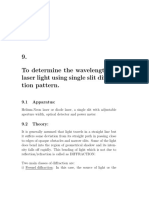SingleSlitDiffraction
Uploaded by
Kingshuk SarkerSingleSlitDiffraction
Uploaded by
Kingshuk SarkerExperiment 19 Measurement of light intensity distribution of single
slit diffraction
[Aims of experiment]
1. Observe Fraunhofer diffraction of single slit to deepen the understanding
of diffraction theory.
2. Measure the relative light intensity distribution of single slit diffraction with
photoelectric elements and master its distribution pattern.
3. Learn to determine tiny quantities by diffraction method.
[Apparatus required]
He-Ne laser (wavelength 632.8nm, power 1.5mW ); single slit; optical bench;
observation screen; silicon photocell (photoelectric probe); micrometer drum;
photocurrent amplifier (power meter)
[Principle]
When light passes through obstacles during propagation, a portion of the light
energy propagates into geometric shadows, resulting in diffraction
phenomena. If the size of the obstacle is close to wavelength of the light,
diffraction phenomena are more easily observed.
Diffraction can be divided into Fresnel diffraction and Fraunhofer diffraction
based on the distances from a light source and an observation screen to a
diffraction obstacle (diffraction object). The former refers to diffraction when
either the distance from a light source to a diffraction object or that from an
observation screen to a diffraction object is finite. The latter refers to
diffraction when both distances from a light source and an observation screen
to a diffraction object are infinite. Thus, to achieve single slit Fraunhofer
diffraction, it is necessary to ensure that the distance from a light source to a
single slit and from a single slit to an observation screen are both infinite, that
is, both an incident light and a diffraction light generated on the single slit are
parallel light.
The laser is of good directionality and can be regarded as a parallel beam. By
irradiating a very fine slit (width a of 0.05~0.1mm) with a laser and placing an
observation screen further than 850mm behind the slit, the Fraunhofer
diffraction fringes can be seen.
Replace the observation screen with a silicon photocell (photoelectric probe),
which can move in a direction perpendicular to the diffraction pattern.
Therefore, the current displayed by the ammeter connected to the probe is
proportional to the light intensity falling on the probe. Experimental setup is
shown in Fig1.
Fig 1. Experimental setup of single slit diffraction
According to Huygens-Fresnel's principle, the intensity distribution of a single
slit diffraction is as follow.
( )
2
sinU , πa sin θ πax
I =I 0 U= ≈
U λ λD
Where I0 is light intensity at center point of the central brightest fringe; is
wavelength of the incidental light; is a diffraction angle; D is the distance
from single slit to silicon photocell; x is distance from center point to
measurement point and I is light intensity of position x.
Therefore, the diffraction fringes obtained are a series of stripes parallel to the
single slit. When x=0, I=I0, which is the highest light intensity and stands for
the central brightest fringe. When x=kD/a (k=1, 2…), I=0, which are the
lowest light intensity and stand for the dark fringes. Besides the central
brightest fringe, there is also a brighter fringe between two adjacent dark
fringes, which is called secondary maximum. The light intensity distribution
curve of single slit diffraction is shown in Fig2.
Fig 2. Light intensity distribution curve of single slit Fraunhofer diffractoin
The width of the central brightest fringe x=2D/ a. And the width of single slit
a can be expressed as:
a = kD/x.
If the position x of the kth dark fringe is measured, the width a of a single slit
can be obtained from the above equation.
[Procedures]
1. Turn on He-Ne laser and silicon photocell(photoelectric probe). Preheat for
10min.
2. Position the single slit 15cm in front of the laser. And place the observation
screen in front of the probe.
3. Pass the laser through the single slit. Adjust the level, height, and
inclination of the slit to make the diffraction pattern horizontally and
symmetrically. Then rotate the knob next to the single slit plate to change
the slit width and observe the variation of the diffraction pattern.
4. Remove the observation screen and allow the diffraction light to enter the
probe. Rotate the micrometer drum to move position of the probe
horizontally until the value shown on the photocurrent amplifier reaching
its maximum, which stands for the center of the central fringe.
5. Record the maximum light intensity value I 0, which is corresponding to the
center point of the light intensity curve (x=0). Continue rotating the
micrometer drum and record the light intensity value every 0.3mm until it
reaches the third dark fringe. Record the relevant data in Table 1.
6. Record the distance D from the single slit plate to the probe in Table 1, as
well.
[Datasheet]
Table 1 Datasheet for light intensity measurement of single slit diffraction
Distance from single slit to probe D= cm; Wavelength of laser = nm
N I
0~9
10~1
9
20~2
9
30~3
9
40~4
9
P.S. N is a serial number, corresponding to coordinates N * 0.3mm
[Data processing]
1. Light intensity of the central bright fringe is I 0, and the relative intensities
of other points are I/I0. Plot a relationship curve of I/I 0 ~x (single slit
diffraction relative intensity distribution curve) on a coordinate paper.
2. Calculate the single slit width a based on the recorded dark fringe
positions, and then get its average value.
[Notes]
1. Avoid staring into the laser beam.
2. Don’t directly illuminate laser on silicon photocell.
3. Preheat the laser and silicon photocell for 10~20min.
4. When adjusting the width of a single slit, the value of the drum knob
should not be lower than zero in order not to damage the cutting edge.
[Questions]
1. What conditions should single slit Fraunhofer diffraction meet? How are
those conditions satisfied in the experiment?
2. Why should the central brightest fringe be found?
3. How is light intensity distribution of single slit Fraunhofer diffraction?
You might also like
- Sheqxel Workplace Inspection Dashboard TemplateNo ratings yetSheqxel Workplace Inspection Dashboard Template28 pages
- Diffraction of Light From Single Slit and Pin HoleNo ratings yetDiffraction of Light From Single Slit and Pin Hole8 pages
- Single Slit Experiment. Physics Investigatory ProjectNo ratings yetSingle Slit Experiment. Physics Investigatory Project11 pages
- Diffraction and Spectroscopy: Harsh MenonNo ratings yetDiffraction and Spectroscopy: Harsh Menon9 pages
- 7-Diffraction at A Slit and Double Slit PDFNo ratings yet7-Diffraction at A Slit and Double Slit PDF9 pages
- Intensitas Difraksi Beberapa Celah Dan GridNo ratings yetIntensitas Difraksi Beberapa Celah Dan Grid6 pages
- Single, Multiple Slit Diffraction - LabManualO4No ratings yetSingle, Multiple Slit Diffraction - LabManualO410 pages
- Diffraction From Single Slit: 1 Test Your UnderstandingNo ratings yetDiffraction From Single Slit: 1 Test Your Understanding2 pages
- PHY227-Lecture12 Diffraction by A Single Slit PDFNo ratings yetPHY227-Lecture12 Diffraction by A Single Slit PDF13 pages
- PHY227-Lecture12 Diffraction by A Single Slit PDFNo ratings yetPHY227-Lecture12 Diffraction by A Single Slit PDF13 pages
- PHY227-Lecture12 Diffraction by A Single SlitNo ratings yetPHY227-Lecture12 Diffraction by A Single Slit13 pages
- Optics Comple - Fraunhofer Diffraction - Converted 2No ratings yetOptics Comple - Fraunhofer Diffraction - Converted 25 pages
- To Determine The Wavelength of Laser Light Using Single Slit Diffrac-Tion PatternNo ratings yetTo Determine The Wavelength of Laser Light Using Single Slit Diffrac-Tion Pattern8 pages
- Diffraction: Dr. Prabal Pratap Singh BhadauriaNo ratings yetDiffraction: Dr. Prabal Pratap Singh Bhadauria43 pages
- Diffraction of LASER Light Using Various AperturesNo ratings yetDiffraction of LASER Light Using Various Apertures9 pages
- Phenomenon of Diffraction of Light WaveNo ratings yetPhenomenon of Diffraction of Light Wave23 pages
- Physics 223 Experiment 7: Diffraction From A Single Slit: March 24, 2009No ratings yetPhysics 223 Experiment 7: Diffraction From A Single Slit: March 24, 20092 pages
- Human Resource Management Assignment Case Study - Job Analysis at Go-ForwardNo ratings yetHuman Resource Management Assignment Case Study - Job Analysis at Go-Forward11 pages
- Line Tracking Robot AUTO-CAD 3D Design Project Exhibition: COMSATS Engineering Robotics CompetitionNo ratings yetLine Tracking Robot AUTO-CAD 3D Design Project Exhibition: COMSATS Engineering Robotics Competition2 pages
- Cell Line Profile: ECACC Catalogue No. 84113001No ratings yetCell Line Profile: ECACC Catalogue No. 841130012 pages
- 48.lamp Illumination Control System Using Sensor CircuitNo ratings yet48.lamp Illumination Control System Using Sensor Circuit4 pages
- LINK BUILDING - Find Guest Post OpportunitiesNo ratings yetLINK BUILDING - Find Guest Post Opportunities1 page
- Ch-2&3; particle and fiber board ppt (2)No ratings yetCh-2&3; particle and fiber board ppt (2)19 pages
- ALMCO Risk Assessment Kitchen & Dinning Area-JAN 2021No ratings yetALMCO Risk Assessment Kitchen & Dinning Area-JAN 202110 pages
- Diffraction of Light From Single Slit and Pin HoleDiffraction of Light From Single Slit and Pin Hole
- Single Slit Experiment. Physics Investigatory ProjectSingle Slit Experiment. Physics Investigatory Project
- Diffraction From Single Slit: 1 Test Your UnderstandingDiffraction From Single Slit: 1 Test Your Understanding
- Optics Comple - Fraunhofer Diffraction - Converted 2Optics Comple - Fraunhofer Diffraction - Converted 2
- To Determine The Wavelength of Laser Light Using Single Slit Diffrac-Tion PatternTo Determine The Wavelength of Laser Light Using Single Slit Diffrac-Tion Pattern
- Diffraction of LASER Light Using Various AperturesDiffraction of LASER Light Using Various Apertures
- Physics 223 Experiment 7: Diffraction From A Single Slit: March 24, 2009Physics 223 Experiment 7: Diffraction From A Single Slit: March 24, 2009
- Human Resource Management Assignment Case Study - Job Analysis at Go-ForwardHuman Resource Management Assignment Case Study - Job Analysis at Go-Forward
- Line Tracking Robot AUTO-CAD 3D Design Project Exhibition: COMSATS Engineering Robotics CompetitionLine Tracking Robot AUTO-CAD 3D Design Project Exhibition: COMSATS Engineering Robotics Competition
- 48.lamp Illumination Control System Using Sensor Circuit48.lamp Illumination Control System Using Sensor Circuit
- ALMCO Risk Assessment Kitchen & Dinning Area-JAN 2021ALMCO Risk Assessment Kitchen & Dinning Area-JAN 2021

























































































